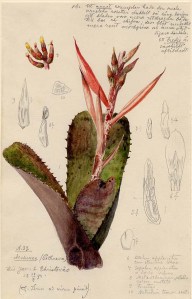This post in the series (1,2) on the whereabouts of early modern herbaria begins with two notable collections in Switzerland, Felix Platter’s (1536-1614) at the Bern City Library and Caspar Bauhin’s (1560-1624) at the University of Basel’s herbarium. Both are significant and both were the subject of an article by Davina Benkert (2016), where she does a wonderful job of describing each and comparing them. As with many collections this old, portions are missing. Platter eventually bound his specimens and had 18 volumes of which nine survive. In many cases, he pasted a plant on the right hand page and one or more illustrations on the left. Among these are prints as well as watercolors, including 77 by Hans Weiditz, the originals of the plates used in Otto Brunfel’s 1530 Herbarum vivae eicones. Paper being valuable, Weiditz had painted on both sides of each sheet. Wanting to get the most out of them, Platter cut them out so he could use both plants, sometimes painting in parts that were missing. He also at times “fiddled” with specimens, such as pasting stamens to the outside of tulip flowers to make them visible. These practices horrify present-day art historians and botanists, but this was early modern botany and techniques had yet to be codified.
Bauhin was Platter’s student at the University of Basel and they collected together. Eventually Bauhin joined the faculty and worked on his plant compendium, Pinax theatri botanici published there in 1623. They used the specimens differently, so they treated them differently. Platter used his in teaching and as reference. Though he had early on kept his specimens loose, he eventually preferred bound volumes because they allowed him to show his collection to visitors, something he relished, without damaging the plants. He used Bauhin’s classification system. Even though it hadn’t been published yet, he was obviously privy to the manuscript.
On the other hand, Bauhin was trying to build a comprehensive collection to use in creating a planned work on taxonomy. He kept his specimens loose, slipped between folded sheets of paper with identification slips. This enabled him to reorganize them as his ideas about relationships among them changed, but it also meant fragments and labels could easily slip out. It also made it easier to remove specimens. Bauhin’s collection continued to be used for teaching and reference after his death. His descendants allowed botanists to select specimens, which explains why two-thirds of the originals are gone (Benkert, 2016). In 1774, what remained was purchased by Werner von Lachenel, a University of Basel botanist who integrated the sheets into his own herbarium. When the University acquired his herbarium, they then sorted out Bauhin’s sheets, but 400 were in such poor condition they were discarded. Here at least we have some idea of why the collection is so greatly reduced. In many cases, the dwindling of a collection isn’t as well documented. I should add that sometimes items are later found as when 300 of Ulisse Aldrovandi’s specimens (see last post) were discovered in a later Italian collection (Mossetti, 1990). Again, this might seem horrifying, but it is really a form of borrowing, a common practice; it’s just that in the Bauhin and Aldrovandi cases it was done posthumously.
Alette Fleischer (2017) has written an article with a great title Leaves on the Loose and subtitled “The Changing Nature of Archiving Plants and Botanical Knowledge” and that deals with these issues. She notes that when herbaria were unbound all ties could be lost to the history of a sheet and who made it. She sees the digitization of old collections as a boon to “recombining” specimens, setting them next to each other for comparison. James Petiver, an avid British collector, amassed over 100 herbaria, which eventually become part of Hans Sloane’s herbarium, now at the Natural History Museum, London. Fleisher writes that “According to his beliefs on order, Petiver compiled, or more precisely recompiled nearly every herbarium that came into his possession. . . . He not only took sheets from older herbaria, but also cut out bits of paper and plants and glued these together with other specimens, thereby losing labels, names, and information” (pp. 125-126).
Reading statements like this explains a lot about why the early history of herbaria is fragmentary. It also makes what is available that much more wonderful. Particularly wonderful is the website that has been created around Platter’s herbarium, with the pages organized by volume and by species names. In addition there are webpages with information on Platter and the collection’s history. It’s thrilling to be able to closely study the pages, especially those with Weiditz images. The University of Basel herbarium website states the Bauhin herbarium has been imaged, but I could not find a link to it, so I am not sure if it is available online. In time it probably will be, another wonderful digital treasure. In the meantime, the Platter volumes would keep anyone with an interest in early modern botany busy for a long time.
References
Benkert, D. (2016). The ‘Hortus Siccus’ as a focal point: Knowledge, environment, and image in Felix Platter’s and Caspar Bauhin’s herbaria. In S. Burghartz, L. Burkart, & C. Göttler (Eds.), Sites of Mediation (pp. 211–239). Leiden: Brill. https://doi.org/10.1163/9789004325760_010.
Fleischer, A. (2017). Leaves on the loose: The changing nature of archiving plants and botanical knowledge. Journal of Early Modern Studies, 6(1), 117–135. https://doi.org/10.5840/jems2017616.
Mossetti, U. (1990). Catalogue of Ulisse Aldrovandi’s herbarium: The specimens found in the herbaria of Giuseppe Monti and Ferdinando Bassi. Webbia, 44(1), 151–164. https://doi.org/10.1080/00837792.1990.10670471.


